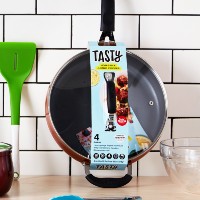 As publishers increasingly look for alternative revenue streams to support stuttering ad revenues, branded products and ecommerce are emerging as a popular choice for the digital natives.
As publishers increasingly look for alternative revenue streams to support stuttering ad revenues, branded products and ecommerce are emerging as a popular choice for the digital natives.
The basic concept is a tried and tested one. For the right publishers, consumers’ affinity with the brand is strong enough that they’ll happily pay for products bearing that brand. The likes of Vogue, Mad Magazine and Playboy have been selling licensed wares for decades now, using their own media to promote these products.
“Traditional publishers – Meredith, Conde Nast, Hearst, etc. – have been active (and successful) in brand licensing for many years,” said Eric Karp, SVP of global brand licensing at BuzzFeed. “It was only a matter of time before digital-first publishers would embrace the same kind of diversification. What’s surprising is that it took so long for them to see the merits of these brand extensions, both as a revenue driver and as a way to deepen followers’ affection for the brands themselves.”
But while the basic concept remains the same, digital capabilities open up a number of new opportunities around branded products.
Firstly, and perhaps most obviously, digital publications can sell their products directly through an ecommerce section on their site. Gone are the days of asking readers to cut out and post a product order form from the back of a magazine. The purchase path is much smoother for customers, while the publishers themselves get real time insights into what’s selling well.
Hearst has been looking to ecommerce in recent years as a form of revenue diversification, primarily as a way to sell third-party products directly through its magazine websites. And Betsy Fast, chief content development officer at Hearst Europe, said that ecommerce sales have grown quickly during the pandemic, with revenues up 180 percent year-on-year.
“We began diversifying into ecommerce in 2017,” said Fast. “As a business with globally renowned, trusted brands, we have seen more and more consumers gravitating towards brands they can rely on, particularly during these testing times. Whether looking for the best exercise equipment for home-workouts, the most effective beauty products for DIY treatments, or doctor-endorsed advice on buying face masks, we do everything we can to ensure they’re covered.”
The other big opportunity afforded in the digital world is the ability to use detailed data on audiences’ interests to guide product strategy.
For many digital-first publishers, this sort of detailed audience analysis is part of their business structure anyway, looking at trends in what’s proving popular in order to guide their content strategy. So it’s a fairly natural process to extend this approach to branded products too.
“Both our content and our ecommerce strategies take an audience-first approach, so there’s a natural synergy there,” said BuzzFeed’s Eric Karp. “We bring to market products that we know will resonate with consumers based on audience signals and the constant feedback loop we gain from our content.”
These detailed audience signals let publishers spot less-obvious opportunities for branded products. British social publisher Jungle Creations, for example, sells personalised socks with readers’ pets printed on them, while BuzzFeed has released a sex toy in partnership with sexual wellness brand Bellesa.
This data informs not only the types of products that are sold, but the more specific details of how those products should look, too. Jungle Creations’ managing director of commerce Olly Johnson said this is the case for a new line of craft kits being released for Jungle Creations’ Craft Factory brand.
“Having such rich data at our disposal enables us to define exactly which crafts we predict will drive the best engagement for high conversion and revenue,” said Johnson.
Balancing Risk Against Reward
Once products are designed, there are no hard and fast rules about how they’re marketed and sold. Those VideoWeek spoke with said the setup will vary from product to product. Since these products will often be produced in collaboration with a third-party brand, there may be commitments within these deals relating to advertising and promoted content.
There are obviously risks with this strategy, though. Whenever a publisher starts creating their own products, it puts them in competition with businesses which might advertise on their sites, which could harm their ad business.
“In very basic terms, it comes down to where the scalable opportunity is over time with the greatest ROI,” said Jungle Creations’ Johnson. “If there’s an opportunity to acquire new customers with our own product that has potential for a high retention rate and lifetime value, then we’ll deliver much greater revenue over time. It’s a trade off with the short term and longer term strategy.”
And publishers also need to be conscious of coming across as over-commercialised. If too much of a media company’s business is geared towards advertising and products sales, it could alienate their audiences.
“Just because you can do something, doesn’t mean you should – the product needs to bring value to the consumer and needs to be authentic to your brand identity, otherwise it won’t be successful,” said BuzzFeed’s Karp. “It’s important to learn from your audience and truly understand their motivations and preferences, and then be strategic about using your platform to message and market products to your audience.”
But when executed well, branded products and ecommerce can have the opposite effect – opening up new opportunities for brand collaborations, and building deeper relationships with audiences.
“Brands endeavour to offer a 360 brand experience, so we’re seeing many make great strides to take the online digital product to meet an offline physical product,” said Jungle Creations’ Johnson. “That ultimately enhances relationships with existing customers (or fans), and increases reach to acquire new ones.”




